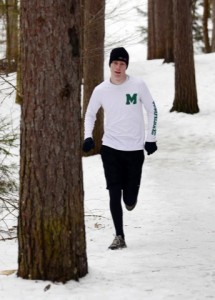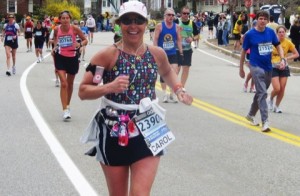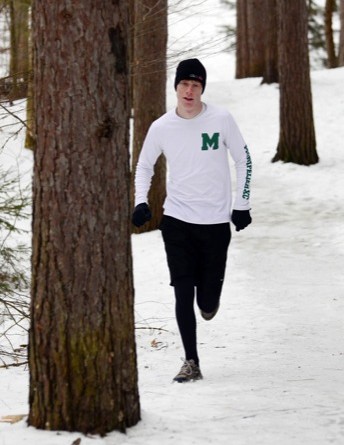Slug It Out Today, Triumph in May | Tough the Cold and Ice for a Better Race Come Spring Marathon Season

Winter’s mean streets are often too much for some automobiles. But when you’re aiming for a spring marathon, you have to tough it out and hit the pavement—now.
Most marathon training plans are about 16 to 20 weeks long. April and May kick off each year’s marathon season, and many local runners have their sights set on two biggies. Boston, the granddaddy of marathons, is held on Patriots Day (April 16), while Burlington’s own Vermont City is held on May 27, during Memorial Day weekend. Those training for Boston have most likely already begun training. If the KeyBank Vermont City Marathon is your race, the time is now to don neck warmers and running tights, and get out there.
Now, you say? In the dead of winter? That’s right. Spring marathoners have to be motivated excuse-busters because February and March present plenty of excuses for why not to run. “Weather, cold, snow, darkness, and life in general can all make it tough,” says endurance athlete, running coach, and Brooks I.D. (that’s “Inspire Daily”) runner Kelly Wilson of Essex.
Wilson runs 12 months a year, and she trains runners. Her best advice for finding the inspiration to run during the cold and lonely winter months is that the motivation does not always need to come from within. “Find a group,” she says. In particular, it’s nice to have companionship during the weekly long runs of a marathon-training program. Most running groups meet on weekends with the expressed purpose of helping fellow members get through their long runs. Groups also become great places to find buddies with whom to do short midweek runs.
When Wilson assesses one of her runners, the first question she asks is, where is that runner when he or she starts preparing for a race? Anyone can look up a marathon training calendar online. If a runner is already running 12 miles at a time, then Wilson wouldn’t start at the beginning of a schedule that calls for a 6-mile-long run in week one.

Secondly, she looks at each individual’s situation. What work commitments, family commitments, and so forth, does a person have? Runners have to be realistic and customize their training calendar to their lifestyles. Are they doing all of their runs before or after work? Do they travel all winter? Do they have a treadmill at work? All of these will affect marathon training this winter, so Wilson customizes her training plans for the individual.
Many runners think they can beat the cold by running on a treadmill. Is it realistic to think that a treadmill runner will log the hours necessary for marathon training on a machine?
Wilson isn’t sure. “I try to train outside for an event that will be held outside,” she says. She knows runners who use indoor tracks when the weather gets especially harsh. There aren’t that many indoor tracks in Vermont, though, outside of the University of Vermont, Indoor Recreation of Orleans County, and the Sports and Fitness Edge. “Someone would probably make a million if they built one,” Wilson says.
One challenge that VCM—and other spring marathons in the Northeast—present is unpredictable race-day weather. Any VCM or Boston veteran will tell you that the weather has ranged from freezing to cold and rainy to sunny, hot, and humid. Wilson’s advice: take advantage of weather challenges during your training. “In March and April, you may not want to run in the rain,” she says. Well, race day may very well be a rainy day, so it makes sense to take advantage of rainy training opportunities.
Likewise, it is difficult to prepare for a warm VCM. Memorial Day weekend could be summerlike—the opposite of VCM’s February, March, and April ramp-up. “If there’s a warm snap, and you usually run early in the mornings,” says Wilson, “maybe think about postponing your run one day until the heat of the day.” This way, she says, you get at least some preparation in warmer temperatures. Wilson knows a thing or two about trying to prepare for a warmer-weather event in a Vermont climate; , she was getting ready to run the Coastal Challenge Route of Fire in Costa Rica, a six-day event covering 250 kilometers.
While Wilson worries about a winter training program for a run in the tropics, most marathon runners here have concerns that are closer to home. Like what to wear while training. Wilson dresses in layers, so she can take off a layer once she’s underway. “The first 10 minutes are always the worst,” she says. Many people wear traction devices like Yaktrax and Icespike, but Wilson does not; she is comfortable training in trail shoes. If you are training before or after work, you are definitely accustomed to running in the dark. Reflectors and lights—both in your front and back—are a must; drivers simply will not see you otherwise.
Running springtime marathons like Boston and VCM are great ways to usher in summer. But springtime marathons require wintertime preparations. Running a marathon requires dedication, toughness, and determination. And where do runners develop these traits? In the long, cold, and (sometimes) lonely months prior to race day. It’s in these months leading up to a marathon event when the real race is run.
Strength in Numbers
Run with these groups for camaraderie and support
Run With Jan
When: Sundays at 8:15 a.m.
Where: location changes weekly
runwithjan.com
The Sunday Run, sponsored by RunVermont and Green Mountain Athletic Association
When: Sundays at 8 a.m.
Where: The Sports and Fitness Edge on Farrell Street, South Burlington
vermontcitymarathon.org
Weekly Social Fun Run
When: Thursdays at 6 p.m.
Where: SkiRack on Main Street, Burlington
skirack.com
Editor’s note: Montpelier’s Mari Zagarins has signed up for the KeyBank Vermont City Marathon. She’s sharing her training progress on our blog, Get Out.



